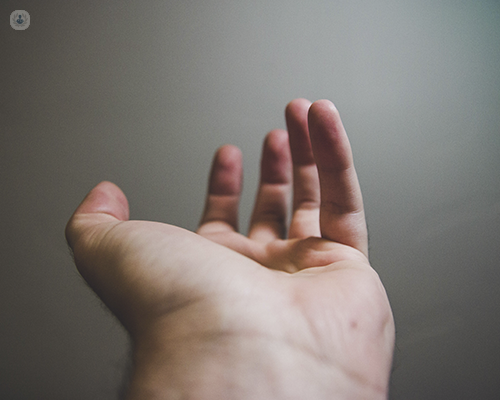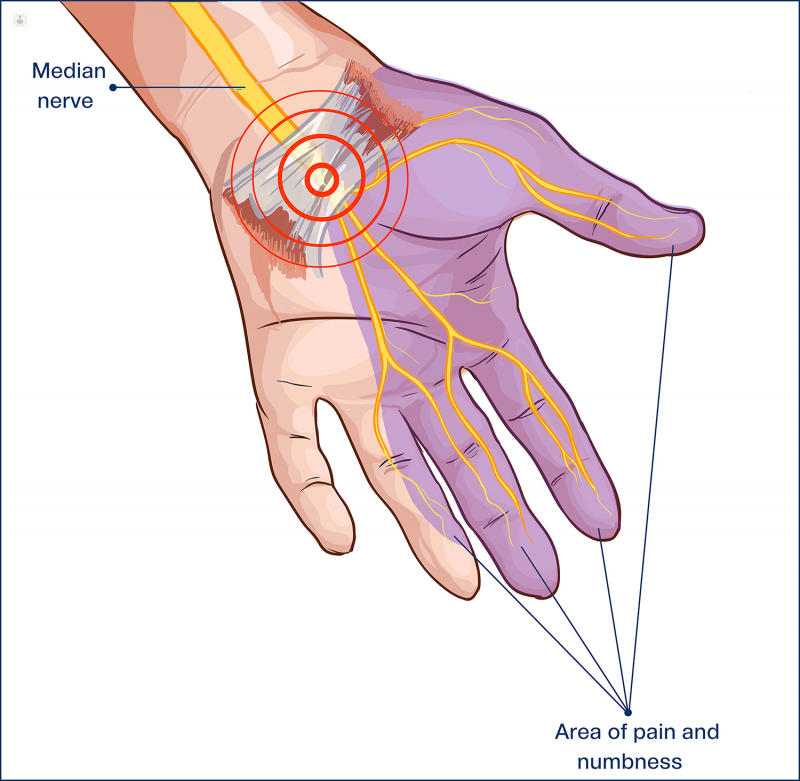Untreated carpal tunnel syndrome
Escrito por:Carpal tunnel syndrome (CTS) is the compression of an important nerve (the median nerve) in your wrist. Miss Tanaya Sarkhel, an orthopaedic surgeon who specialises in hands and wrists, explains what happens when you don’t receive treatment for this common condition.

What is carpal tunnel syndrome?
Carpal tunnel syndrome (CTS) is a structural problem in which the median nerve gets squashed. The median nerve goes through your carpal tunnel -which is in your wrist, right next to your palm- to the hand. When it gets squashed, its ability to transmit signals becomes impaired.
It might help to think of the median nerve like a garden hose in full flow: whilst there is nothing obstructing it, the water (nerve signal) is able to flow freely at full pressure. If you rest your foot on the hose, the water is forced out under higher pressure in all directions (in the case of CTS, this high pressure would feel like pins and needles). If you put your foot down hard on the hose, the water is shut off completely (numbness, muscle wasting). If you leave your foot on the hose for a length of time, the sides of the hose become stuck together and it is no longer possible to get any water through, even if you take your foot away (irreversible nerve change).
What happens if you don’t get treatment?
The rationale for treatment is based on improving your symptoms. If you can’t sleep through the night because you’re waking up to shake your hand free of pins and needles or numbness, or you are dropping things and lacking the dexterity needed to pick up small objects, then that situation probably isn’t going to change unless the pressure on the nerve is dealt with.

What type of treatment is used?
Nerve conduction studies are helpful in getting a feel for how reversible or irreversible the pressure on the nerve is and these track how fast an electrical impulse can pass through your nerve. The Canterbury grading system goes from 0-6 and states the severity of the condition.
- Symptomatic patients with Grades 0, 1 or 2 carpal tunnel syndrome are frequently helped with non-surgical techniques such as splinting, stretches and steroid injections.
- Grade 3 patients often try the steroid injection first and if that does not improve the situation then surgery becomes an option
- Symptomatic patients with grade 4, 5 or 6 compression find that non-surgical methods do not reliably help and a conversation about surgical release under local anaesthetic is had.
What is the goal of treatment?
The goals of treatment are to resolve symptoms. If, however, the nerve is already squashed to a point where full recovery after surgery may not always be possible (Grades 5 and 6) or you have an additional condition such as diabetes where progressive nerve deterioration is already a consideration, then the goals or treatment are to stop things getting any worse. In any case, your doctor will guide you on the decision. Pins and needles is usually a symptom that can be reversed by treating the compression. It is a sign that the nerve is unhappy but still able to send signals.
How do you know if it has become irreversible?
Signs that the nerve is becoming irreversibly squashed include numbness to the tips of the thumb, index and middle fingers, and a change in shape or loss of the muscles that move your thumb. As the nerve continues to suffer under pressure, numbness can extend to cover the fingers and palm. This means you might not notice if you scalded yourself, get cuts to the skin or infections.
It is highly unusual these days to see patients with a disappearance of the thumb (thenar) muscles but if that happens, the thumb loses flexibility and cannot be made to touch the tips of the other fingers (opposition). Whilst these signs are all of the irreversible nerve damage, it would be even more important to take the pressure of the nerve to save what residual function is left.
Should I get treatment?
If you are experiencing persistent pins and needles that is perhaps disturbing your sleep or affecting your dexterity, have a conversation with your doctor about the steps you can take to identify the severity of the problem and talk through the options.
If you’re having doubts about your hand and wrist health, don’t hesitate to book a consultation with Miss Tanaya Sarkhel. You can do so by clicking on her profile .


